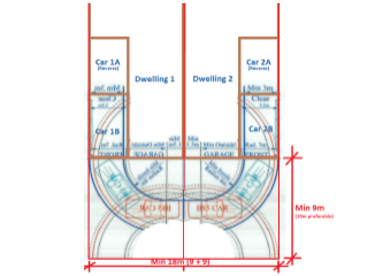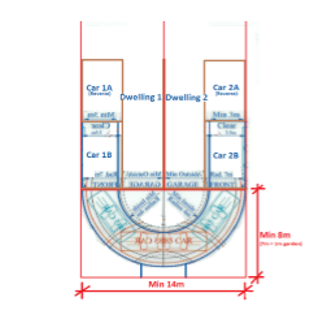
[CE 2.1]
| Title | Arterial Road Network Traffic Impact Analysis |
| Duration | June 2018 – January 2020 |
| Location | Burwood East, Victoria, Australia |
| Organization | VicRoads (now Department of Transport) |
| Position | Statutory Referrals Officer/Engineer |
[CE 2.2] VicRoads (now Department of Transport) is a Governmental State mainly works in owning, managing, and regulating the Victoria’s arterial road network. I worked for the Metro South East (MSE) region of VicRoads located in Burwood East, Victoria. As a road authority, every region has various teams such as project development, project delivery, traffic signals, strategic planning, Asset management, vehicular movement and safety, statutory referrals, etc. to manage and maintain the arterial road network within the region. The statutory referrals team looks after all the planning referrals referred by the Councils to VicRoads. The council refer to the relevant development applications under the planning and environmental act 1987 and it was linked with VicRoads for assessment. The applications which could have adequate dependency on the operational efficiency and safety of the arterial road network.
[CE 2.3] The main objective was to assess the planning application referred by the Council and ensure that the development proposed did not have any appropriate public safety impact along with analyzing the operational efficiency of the existing arterial road network. This included ensuring that all the vehicles from the development enter and exit the site in forwarding direction efficiently without creating any hazardous situation for pedestrians on cyclists using the footpath or vehicles traveling on the arterial road. Therefore, reviewing all the submitted development plans to make sure that it achieves that if it doesn't then refuse the application and ask the developers to amend the plans accordingly.
[CE 2.4] The work nature was reviewing the anticipated traffic generated by the proposed development and its associated arterial road network impacts. The application process included Traffic Impact Assessment Report (TIAR) which included development of traffic impact analysis on the road network. Reviewing such TIARs against the traffic guidelines (AustRoads guidelines, Australian Standards, VicRoads Traffic Engineering Manuals, etc.) to ensure that appropriate road treatments are being proposed to cater to the anticipated traffic generation by the development. If the development is proposing any mitigation works on the arterial road network, I have to ensure that those works are in accordance with the standard guidelines.
[CE 2.5]

[CE 2.6] My project duties:
[CE 2.7] There was one complex planning application for mixed-use development the anticipated traffic generation of the development was significant, and the development did not propose any mitigation works along with the road network. As such, while assessing the application I noticed that the anticipated traffic generated by the development had a significant impact of the 3 intersections which are managed by VicRoads. Therefore, it was important to provide some sort of works on the network to cater to the potential traffic and to maintain the existing operational efficiency of the road network. Therefore, I refused the application and had several meetings with the applicant and the traffic consultants to resolve the issues, even after pointing out our concerns and the safety hazard the development was creating on the road. However, they did not propose any sort of mitigation works. Finally, the application was appealed at Victorian Civil and Administrative Tribunal (VCAT). I conducted a site inspection for assessing the road network surrounding, the area pattern traffic distribution and the existing traffic condition of the most congested road. After analyzing the collected data with the SIDRA analysis submitted by the applicant, I came up with few possible mitigations works that can cater the potential impact of the anticipated traffic generated by the development without impacting the safety and operational efficiency of the road network. The works included by creating alterative options for motorist such as improvising the nearby intersections along the road to distribute the traffic on the road network instead of saturating at a single point. A U-turn lane and couple of existing right turn deceleration lanes were recommended to extend in accordance with the specific standards. Furthermore, I discussed those options with my team leader so that I can recommend the ideas to the applicant to consider. The applicant accepted the changes recommendations and matter was resolved at mediation hearing at VCAT.
[CE 2.8] The team used to struggle on the few development plans to decide on whether the vehicles were able to enter and exit the site in the forward direction or not? These are the applications where the documents do not include swept path diagrams to demonstrate the vehicle movements in and out of the development. To make this task easy for everyone and avoid further information request only for swept paths, I prepared a drawing/sketch using turn-templates from defined Australian standards demonstrating the minimum space required for a vehicle that dwelling the entry and exit points in the forward direction. This reduced the avoidable time in assessing the application. At one such time, I had an enquiry from a general community member who wanted to construct a new access crossover on the arterial road to provide access to his property. While he can construct a new crossover to his property, however, the design of the access was not in accordance with the guidelines. I assessed the submitted plans against the drawing I prepared to check whether the site has the minimum dimensions required to maneuver a vehicle within the site to enter and exit in forward direction. However, the property has some site constrains such as big tree within the site and dimension from the proposed garage to the property boundary was not enough to allow vehicle to exit in forward direction. As he was a general resident, I had to explain to him the drawbacks of the design using simplified language to explain all the engineering terms and guidelines, and I also explained the impact of vehicles reversing out on arterial road and how it is safety hazard.
[CE 2.9] To help in assessment for my team only, I design the drawing/sketch for the minimum requirement for a vehicle turnaround space within the development to exit in the forward direction using turn templates provided in specific Australian standards.
With two access crossovers:

With single access crossover:

It was very important to have a good understanding of relevant VicRoads policies, AustRoads guidelines, and Australians standards for the assessment of the development applications. Also, the guidance from the senior officers and team leader was an important factor when I joined the team and learn from their experience.
[CE 2.10] After getting an understanding of the whole process, I developed a checklist for the medium density assessment residential dwelling. The checklist purpose was based on providing consistency in the developments assessment and reducing the significant amount of time that we used to put in to assess such applications in the past. The checklist consisted of questions framed to check whether the development is proposed in accordance with the VicRoads requirements as per Australian Standards and AustRoads guidelines. Such as the design of access arrangement, the requirements of passing area etc. Initially, it used to take approximately 1 hour for a single officer to assess one application. However, after using the checklist the time reduced to 20mins per application. Furthermore, as a Road Manager it is our one of the key responsibilities to assess the applications for ensuring that the development did not assist in detrimental impact on any road safety. Therefore, all the applications were assessed and approved only if the provided access arrangement is in accordance with Australian standards and AustRoads guidelines.
[CE 2.11] The region used to conduct various internal training programs to enhance the officer's skills. This internal training was led by the experts within the organization. Out of various training programs, I attended SCATS training, traffic assessment training, etc. I have also attended SIDRA solutions training to get familiar with the SIDRA software. All the senior officers were very helpful, so whenever I had any issue in my assessment, I used to organize a one on one meeting with them. The team used to have a fortnightly catch-up meeting to raise any complex issue which educated everyone on the team. All my assessment reports and response letters were reviewed by Team Leader, so whenever I used to get stuck while assessing the applications I used to organize a meeting with TL/senior officers to get clarification on my doubts. Initially, these catch-ups were frequent however, once I understood the process which was reduced to once or twice a week.
[CE 2.12] When I prepared the checklist for the team for the assessment of medium density residential development, I presented it in front of the team and explained how it works, how it reduced the assessment time, and provided consistency in the assessment. As a part of learning the subjects like transportation engineering from my bachelor's and Transportation systems from my masters played an important role in understanding the works and terminologies easily when I started working. Furthermore, my knowledge and understanding of various AustRoads Guidelines and Australian Standards that I got familiarized to during my master’s degree helped me in assessing the traffic engineering reports of the development proposals.
[CE 2.13] I attained a better understanding of the AustRoads Guidelines and its appropriate applications. I applied better time management skills and liaised with various stakeholders on day to day basis. As a statutory referral officer initially, I used to deal with easy to medium risk applications. However, as I gained more experience in the process and after reviewing my progress and my work rate, my TL started to assign me with the complex applications. And because of my exuberant attitude and proactive nature towards learning I always put my hand up to seize the opportunity to work on complex applications whenever possible. It helped me improve my communicating skills as well as civil engineering skills.
We hold the apex position in providing services regarding CDR writing for engineers Australia. We are known to have very high success records for consistent team of professional writers having years of experience in the field of CDR preparation. We provide the best and trusted service for CDR writing and reviewing of all kinds of engineering disciplines. We provide services for career episode writing, plagiarism check and removal etc.
Should you need any further information, please do not hesitate to contact us.
Contact: +61-4-8885-8110
WhatsApp: +61-4-8885-8110
(Australia, USA, UK, UAE, Singapore, New Zealand)